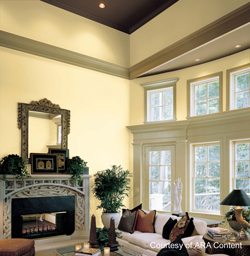 Only the Rich Can Afford to Use Cheap Paint Only the Rich Can Afford to Use Cheap Paint
(ARA) - You’re standing in the aisle at your local paint dealer or hardware
store trying to decide which brand of paint to buy for your living room remodel.
Naturally, you want to save money, so you gravitate towards the less costly
product. What could possibly be the difference between the cheaper paint and the
more expensive brand --paint is paint right? Wrong. Before you cut corners with
your paint, you might want to think twice. Trying to save a few dollars in this
area could prove to be a costly mistake.
Painting is one of the least expensive and most popular ways to change the look
of almost any room in your home. For less than $200 and in a few hours, you can
easily transform a kitchen, bathroom or bedroom from drab to dramatic. So why
scrimp on what you’re going to be looking at for years to come?
Economy paints may have an attractive price, but higher-quality paints are
formulated to produce the best results. According to Mark Kalinowski, former
director of engineering for the Good Housekeeping Institute “Even though
superior paints may cost a few more dollars, the benefits they provide over
budget paints can be numerous. For starters, compared with ordinary paints, top
quality finishes are much easier to work with and offer superior long-term
performances.”
Water: Less Is More
Before you begin your project, how can you determine if a paint is premium,
other than by its price? All paints, oil based and latex, are made of four main
components: water, binder, pigment and additives. When purchasing paint, it’s
important to look at these key ingredients to determine whether you are getting
your money’s worth. As far as top quality paints are concerned; less is more
when it comes to liquid. A can of quality paint should contain a high volume of
solids (pigment and binder), approximately 35 to 45 percent, and less liquid
than ordinary paint. Economy paints are usually made up of only 25 percent
solids. Paints with less water and a higher solid content are more durable and
resist staining and dirt much better than those that contain fewer solids. And,
even if the walls do get spotted or stained, they can be washed off without
damaging the finish. That means you’ll have to repaint less frequently, which
will ultimately save you money.
“When looking for quality paint also try to use one that is made of 100 percent
acrylic, they are particularly durable,” says Bruce Ziegler, Pratt & Lambert
senior product manager. “One of the more popular brands of quality paints is
Pratt & Lambert’s newly reformulated Accolade. It’s made from an award-winning,
100 percent acrylic formula that is unlike any other paint product available.”
Is That Deal, Really A Deal?
After taking these long-term benefits into consideration, if you’re still
hesitant to spend a few extra dollars on a higher quality paint, consider the
following: A superior paint may cost $40 a gallon while an economy brand is
priced at $20; however, by using a better quality paint, you’ll need less of it
to complete a job. For example, you may have to use as many as three gallons of
an economy paint to achieve the same results you would receive using just one
gallon of high quality paint. The cheaper paint actually could end-up costing
you more!
In addition to cost, by using economy paint, you’ll spend an average of two
additional hours on your painting project. And if you’re using a contractor,
that means you’ll have to pay him for the additional time spent on the project.
Why? Since you have to apply more coats of the cheaper paint to achieve the
coverage you desire, it will take more time. The bottom line -- higher quality
finishes are easier to work with because they are formulated with better
ingredients.
Taking all these factors into consideration, remember that although you still
might be tempted to buy an economy paint in order to save a few dollars, in the
short-term and the long-run, what you think is a great deal could end up costing
you more than you bargained for.
Courtesy of ARA Content
Views: 1 | 